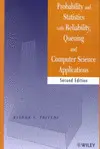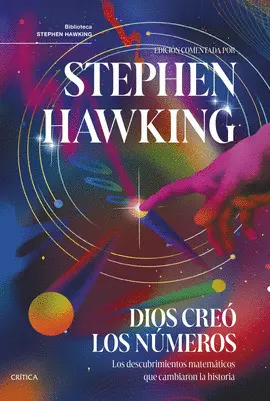- Editorial:
- WILEY
- Materia:
- Ciencia - STEM
- ISBN:
- 978-0-471-33341-8
PROBABILITY AND STATISTICS WITH RELIABILITY, QUEUING AND COMPUTER SCIENCE APPLICATIONS
KISHOR S.TRIVEDI
Book News: This introduction to probability, stochastic processes, and statistics for computer science and engineering applications uses Markov chains and other statistical tools to illustrate processes in reliability of computer systems, fault tolerance, and performance. Chapters cover discrete random variables, continuous random variables, expectation, conditional distribution, stochastic processes, Markov chains, networks of queues, statistical inference, and regression and the analysis of variance. Approximately 200 worked examples are provided for each section. Trivedi teaches electrical and computer engineering at Duke University. Annotation c. Book News, Inc., Portland, OR (booknews.com)
WILEY: An accessible introduction to probability, stochastic processes, and statistics for computer science and engineering applications
This updated and revised edition of the popular classic relates fundamental concepts in probability and statistics to the computer sciences and engineering. The author uses Markov chains and other statistical tools to illustrate processes in reliability of computer systems and networks, fault tolerance, and performance.
This edition features an entirely new section on stochastic Petri nets?as well as new sections on system availability modeling, wireless system modeling, numerical solution techniques for Markov chains, and software reliability modeling, among other subjects. Extensive revisions take new developments in solution techniques and applications into account and bring this work totally up to date. It includes more than 200 worked examples and self-study exercises for each section.
Probability and Statistics with Reliability, Queuing and Computer Science Applications, Second Edition offers a comprehensive introduction to probability, stochastic processes, and statistics for students of computer science, electrical and computer engineering, and applied mathematics. Its wealth of practical examples and up-to-date information makes it an excellent resource for practitioners as well.
An Instructor's Manual presenting detailed solutions to all the problems in the book is available from the Wiley editorial department.
Go to TOP
Biography:
WILEY: KISHOR S. TRIVEDI, PhD, is the Hudson Professor of Electrical and Computer Engineering at Duke University, Durham, North Carolina. His research interests include computer networks, fault-tolerant computing, modeling tools, and reliability modeling.
Go to TOP
Cover & Flap Copy:
WILEY: An accessible introduction to probability, stochastic processes, and statistics for computer science and engineering applications
This updated and revised edition of the popular classic relates fundamental concepts in probability and statistics to the computer sciences and engineering. The author uses Markov chains and other statistical tools to illustrate processes in reliability of computer systems and networks, fault tolerance, and performance.
This edition features an entirely new section on stochastic Petri nets?as well as new sections on system availability modeling, wireless system modeling, numerical solution techniques for Markov chains, and software reliability modeling, among other subjects. Extensive revisions take new developments in solution techniques and applications into account and bring this work totally up to date. It includes more than 200 worked examples and self-study exercises for each section.
Probability and Statistics with Reliability, Queuing and Computer Science Applications, Second Edition offers a comprehensive introduction to probability, stochastic processes, and statistics for students of computer science, electrical and computer engineering, and applied mathematics. Its wealth of practical examples and up-to-date information makes it an excellent resource for practitioners as well.
Preface to the Second Edition ix
Preface to the First Edition xi
Acronyms xiii
Introduction
1 (60)
Motivation
1 (1)
Probability Models
2 (1)
Sample Space
3 (3)
Events
6 (1)
Algebra of Events
7 (4)
Graphical Methods of Representing Events
11 (2)
Probability Axioms
13 (6)
Combinatorial Problems
19 (4)
Conditional Probability
23 (2)
Independence of Events
25 (13)
Bayes' Rule
38 (7)
Bernoulli Trials
45 (16)
Discrete Random Variables
61 (54)
Introduction
61 (1)
Random Variables and Their Event Spaces
62 (2)
The Probability Mass Function
64 (2)
Distribution Functions
66 (2)
Special Discrete Distributions
68 (24)
Analysis of Program MAX
92 (4)
The Probability Generating Function
96 (3)
Discrete Random Vectors
99 (5)
Independent Random Variables
104 (11)
Continuous Random Variables
115 (78)
Introduction
115 (4)
The Exponential Distribution
119 (5)
The Reliability and Failure Rate
124 (5)
Some Important Distributions
129 (19)
Functions of a Random Variable
148 (5)
Jointly Distributed Random Variables
153 (4)
Order Statistics
157 (10)
Distribution of Sums
167 (15)
Functions of Normal Random Variables
182 (11)
Expectation
193 (54)
Introduction
193 (4)
Moments
197 (3)
Expectation Based on Multiple Random Variables
200 (8)
Transform Methods
208 (9)
Moments and Transforms of Some Distributions
217 (11)
Computation of Mean Time to Failure
228 (9)
Inequalities and Limit Theorems
237 (10)
Conditional Distribution and Expectation
247 (42)
Introduction
247 (8)
Mixture Distributions
255 (7)
Conditional Expectation
262 (6)
Impefect Fault Coverage and Reliability
268 (11)
Random Sums
279 (10)
Stochastic Processes
289 (48)
Introduction
289 (5)
Classification of Stochastic Processes
294 (6)
The Bernoulli Process
300 (4)
The Poisson Process
304 (10)
Renewal Processes
314 (5)
Availability Analysis
319 (9)
Random Incidence
328 (4)
Renewal Model of Program Behavior
332 (5)
Discrete-Time Markov Chains
337 (68)
Introduction
337 (4)
Computation of n-step Transition Probabilities
341 (6)
State Classification and Limiting Probabilities
347 (9)
Distribution of Times Between State Changes
356 (2)
Markov Modulated Bernoulli Process
358 (3)
Irreducible Finite Chains with Aperiodic States
361 (16)
* The M/G/1 Queuing System
377 (8)
Discrete-Time Birth-Death Processes
385 (7)
Finite Markov Chains with Absorbing States
392 (13)
Continuous-Time Markov Chains
405 (150)
Introduction
405 (7)
The Birth-Death Process
412 (34)
Other Special Cases of the Birth-Death Model
446 (8)
Non-Birth-Death Processes
454 (42)
Markov Chains with Absorbing States
496 (24)
Solution Techniques
520 (10)
Automated Generation
530 (25)
Networks of Queues
555 (82)
Introduction
555 (5)
Open Queuing Networks
560 (8)
Closed Queuing Networks
568 (28)
General Service Distribution and Multiple Job Types
596 (8)
Non-product-form Networks
604 (13)
Computing Response Time Distribution
617 (13)
Summary
630 (7)
Statistical Inference
637 (90)
Introduction
637 (2)
Parameter Estimation
639 (53)
Hypothesis Testing
692 (35)
Regression and Analysis of Variance
727 (38)
Introduction
727 (5)
Least-squares Curve Fitting
732 (3)
The Coefficients of Determination
735 (3)
Confidence Intervals in Linear Regression
738 (4)
Trend Detection and Slope Estimation
742 (3)
Correlation Analysis
745 (3)
Simple Nonlinear Regression
748 (1)
Higher-dimensional Least-squares Fit
749 (2)
Analysis of Variance
751 (14)
A Bibliography 765 (12)
A.1 Theory
765 (5)
A.2 Applications
770 (7)
B Properties of Distributions 777 (3)
C Statistical Tables 780 (21)
D Laplace Transforms 801 (7)
E Program Performance Analysis 808 (3)
Author Index 811 (8)
Subject Index 819








